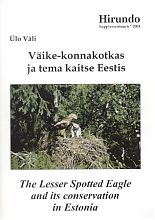Supplementum 6/2003
Ülo Väli
The Lesser Spotted Eagle and its conservation in Estonia
Abstract
This publication is based on the management plan for the Lesser Spotted Eagle Aquila pomarina in 2003-2012. This bird is one of the most numerous eagles in Europe but still classified as a species of conservation concern. 500-600 pairs of Lesser Spotted Eagles breed in Estonia. The nest sites are situated mostly in old spruce-dominated stands, close to forest edge. The eagle prefers to hunt on meadows but flood plains and fields are used, too. Food consists mainly on small mammals while voles are the most important prey group. Reproductive success fluctuates annually. In 1981-2002, the average productivity was 0.62 fledged young per occupied nest.
The most important threat for the Lesser Spotted Eagle in Estonia is the loss of breeding habitats. Disturbance during breeding period and loss of foraging areas are also important factors.
Legally, the Lesser Spotted Eagle belongs to the category of the most strictly protected species in Estonia. This is in accordance with proposals of the EU Action plan for the species. Priorities for future conservation activity are the supervision over the implication of legal conservation tools, monitoring of the population and the awareness-raising. For 2003-2007, seventeen conservation actions are proposed. In habitat protection, including of all necessary habitat protection requirements to the conservation obligations and sending obligations to landowners are the most important actions. The account of the nest sites is held in state-level register, information exchange should be fast and control of nest site protection must be efficient. Numbers and breeding success have to be monitored and results of conservation actions efficiency should be analysed. Spotted eagles and their conservation should be introduced in public training courses and through media. In 2007, the efficiency of management actions will be analysed and the further activity will be planned.

